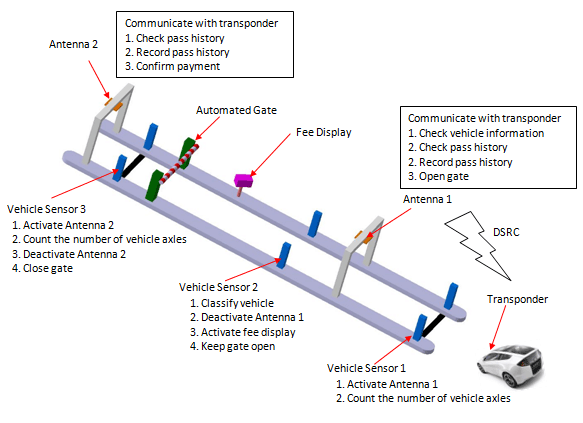Electronic Toll Collection
- Brief Description
-
Electronic toll collection (ETC) systems allow tolls to be collected electronically without requiring vehicles to stop.
They reduce delays at toll gates and help to eliminate traffic jams on toll roads. These systems also increase convenience and safety, reduce commute times, lower fuel use, reduce emissions, reduce costs for toll attendants, and provide reliability and accuracy.
Most ETC systems involve a transponder that can be mounted on a window, bumper or rear view mirror of a vehicle.
The ETC system at the toll gate communicates with the transponder when the vehicle enters, and collects the information it needs to
process a fee transaction. Many ETC systems incorporate road sensors to count the number of axles and determine whether the vehicle is pulling a trailer.
Some have cameras to collect license plate information from vehicles that are not recognized by the system. The image below shows a simplified ETC system model developed by Mitsubishi.

Dedicated Short Range Communications (DSRC)
In the USA, in October 1999, the Federal Communications Commission (FCC) allocated 75 MHz of spectrum in the 5.9 GHz
band for DSRC to be used by Intelligent Transportation Systems (ITS). Most ETC systems now use DSRC communications.
DSRC employs relatively high data rates and is capable of relatively long distance communications independent of weather conditions.
This enables cars to travel through modern electronic toll lanes at full speed.
- Sensors
- RF receiver
- Actuators
- RF transmitter
- Data Communications
- DSRC
- Manufacturers
- Denso, Efkon, JAI, Metro, Mitsubishi, Q-Free, Thales, TransCore, TRMI
- For More Information
- [1] Electronic Toll Collection, Wikipedia.
- [2] List of Electronic Toll Collection Systems, Wikipedia.
- [3] How E-ZPass Works, Kevin Bonsor, HowStuffWorks.com, Aug. 28, 2001.
- [4] ETC in Japan, www.go-etc.jp.
- [5] How Electronic Tolling Works, YouTube, Mar. 2, 2012.
|

